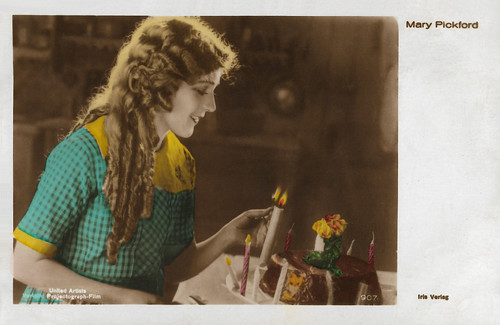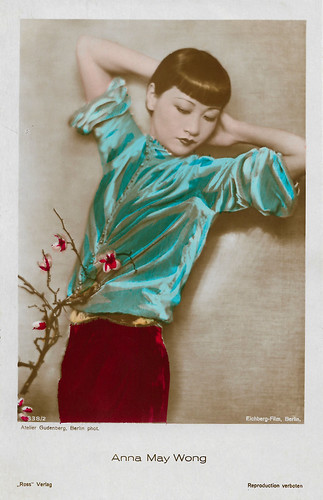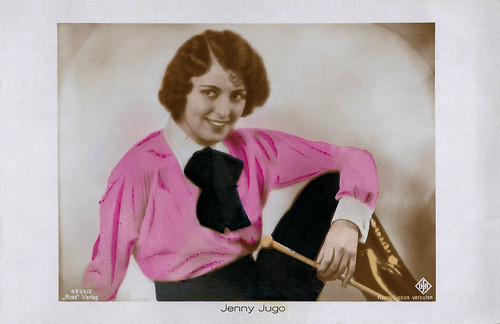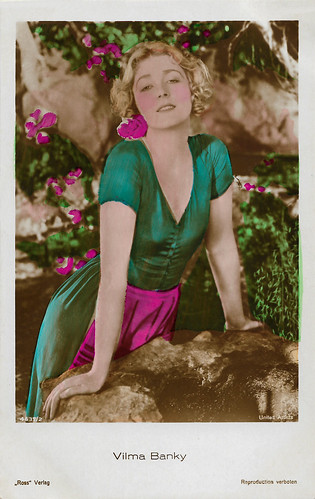Yesterday, EFSP posted on an old postcard album which Egbert Barten of the Geoffrey Donaldson Institute (G.D.I.) received from German film historian and author Kathinka Dittrich. The album contains dozens of German and Dutch postcards which were collected by a Dutch girl around 1930. The album includes several hand coloured film star postcards by Ross Verlag and one by Iris-Verlag which we had never seen before. Today, we share a selection with you.

Austrian postcard by Iris-Verlag, no. 907. Photo: United Artists / Projectograph-Film. Mary Pickford in Little Annie Rooney (William Beaudine, 1925). Collection: Geoffrey Donaldson Institute.
Mary Pickford (1892-1972) was a legendary silent film actress and was known as 'America’s sweetheart.' She was a founder of United Artists and helped establish the Academy.

German postcard by Ross Verlag, no. 4015/1, 1929-1930. Photo: Atelier Sandau, Berlin. Collection: Geoffrey Donaldson Institute.
German actress Brigitte Helm (1908-1996) is still famous for her dual role as Maria and her double the evil Maria, the 'Maschinenmensch', in the silent SF classic Metropolis (Fritz Lang, 1927). After Metropolis she made a string of over 30 films in which she almost always had the starring role. She easily made the transition to sound films, before she abruptly retired in 1935.

German postcard by Ross Verlag, no. 4329/2, 1929-1930. Photo: Paramount. Esther Ralston in The Wheel of Life (Victor Schertzinger, 1929). Collection: Geoffrey Donaldson Institute.
Projected as wholesome but fun-loving, Maine-born leading lady Esther Ralston (1902-1994) enjoyed a prime silent age career. She appeared in close to 100 films over a nearly 30-year period. At her peak, she was packaged and publicised as 'The American Venus' by Florenz Ziegfeld Jr. after appearing as a dazzling beauty queen in the film The American Venus (1926). A decade later, the blonde beauty's career, however, had tapered off.

German postcard by Ross Verlag, Berlin, no. 4338/2, 1929-1930. Photo: Atelier Gudenberg, Berlin / Eichberg-Film, Berlin. Collection: Geoffrey Donaldson Institute.
Anna May Wong (1905-1961) was the first Chinese American movie star, and the first Asian American actress to gain international recognition. Frustrated by the stereotypical supporting roles she reluctantly played in Hollywood, Wong left for Europe, where she starred in such classics as Piccadilly (1929).

German postcard by Ross Verlag, no. 4526/1, 1929-1930. Collection: Geoffrey Donaldson Institute.
Swedish Greta Garbo (1905-1990) is often regarded as one of the greatest and most glamorous movie stars ever produced by the Hollywood studio system. She was part of the Golden Age of the silent film of the 1920s and was one of the few actors who made a glorious transition to the talkies. She started her career in the European cinema and would always stay more popular in Europe than in the USA.

German postcard by Ross Verlag, no. 4536/2, 1929-1930. Photo: Ufa. Collection: Geoffrey Donaldson Institute.
Pretty Austrian actress Jenny Jugo (1904-2001) had a prolific career in German cinema, from the late silent era well into the war years. She did particularly well as comedienne and starred between 1931 and 1942 in eleven smart and charming comedies directed by Erich Engel.

German postcard by Ross Verlag, Berlin, no. 4549/1, 1929-1930. Photo: Alex Binder, Berlin. Collection: Geoffrey Donaldson Institute.
Dutch film star Truus van Aalten (1910-1999) made 29 films in the 1920s and 1930s, and only one of them in the Netherlands.

German postcard by Ross-Verlag, Berlin, no. 4592/1, 1929-1930. Photo: Defina. Collection: Geoffrey Donaldson Institute.
Dignified German-Russian actress Olga Tschechova (1897-1980) was one of the most popular stars of the silent film era. She remained a mysterious person throughout her life.

German postcard by Ross Verlag, no. 4607/1, 1929-1930. Photo: Paramount. Harold Lloyd and Ann Christy in Speedy (Ted Wilde, 1928). Collection: Geoffrey Donaldson Institute.
American actor, comedian, director, producer, screenwriter, and stunt performer Harold Lloyd (1893-1971) is best known for his silent comedies. He ranks alongside Charlie Chaplin and Buster Keaton as one of the three most popular and influential comedians of the silent film. Between 1914 and 1947, Lloyd made nearly 200 comedies, often as a bespectacled 'Glass' character, a resourceful, success-seeking go-getter who was perfectly in tune with 1920s-era United States. His films frequently contained 'thrill sequences' of extended chase scenes and daredevil physical feats. A classic is Lloyd hanging from the hands of a clock high above the street in Safety Last! (1923).

German postcard by Ross Verlag, no. 4637/2, 1929-1930. Photo: United Artists. Vilma Banky in The Awakening (Victor Fleming, 1929). Collection: Geoffrey Donaldson Institute.
Hungarian-born silent film star Vilma Bánky (1898-1991) filmed in Budapest, France, Austria, and Germany, before Sam Goldwyn took her to Hollywood. There she starred opposite great silent stars like Rudolph Valentino and Ronald Colman. She became Goldwyn's biggest money maker till sound finished her career.

German postcard by Ross Verlag, no. 4646/2, 1929-1930. Photo: Atelier Balàzs, Berlin. Collection: Geoffrey Donaldson Institute.
Lee Parry (1901-1977) was a German film actress of the silent and the early sound era, often in films by her husband Richard Eichberg. She appeared in 48 films between 1919 and 1939.

German postcard by Ross-Verlag, no. 4672/3, 1928-1929. Photo: Paramount. Collection: Geoffrey Donaldson Institute.
American actress Clara Bow (1905-1965) rose to stardom in silent film during the 1920s. It was her appearance as a plucky shopgirl in the film It (Clarence G. Badger, 1927) that brought her global fame and the nickname 'The It Girl'. Bow came to personify the Roaring Twenties and is described as its leading sex symbol.

German postcard by Ross Verlag, no. 4710/1, 1929-1930. Photo: Metro-Goldwyn-Mayer. Collection: Geoffrey Donaldson Institute.
American actress Norma Shearer (1902-1983) was the 'First Lady of MGM'.

German postcard by Ross Verlag, no. 4740/2, 1929-1930. Photo: Ufa. Collection: Geoffrey Donaldson Institute.

German postcard by Ross Verlag, no. 4740/3, 1929-1930. Photo: Ufa. Collection: Geoffrey Donaldson Institute.
British born, German actress and singer Lilian Harvey (1906-1968) was Ufa's biggest star of the 1930s. With Willy Fritsch she formed the 'Dream Team of the European Cinema'. Their best film was the immensely popular film operetta Der Kongress tanzt/The Congress Dances (Erik Charell, 1931).

German postcard by Ross Verlag, no. 4769/1, 1929-1930. Photo: Atelier Balázs, Berlin. Collection: Geoffrey Donaldson Institute.
Evelyn Holt (1908-2001) was a highly popular German film actress in the late silent and the early sound era. The rise of the Nazis finished her blossoming film career.

German postcard by Ross Verlag, no. 4784/1, 1929-1930. Photo: United Artists. Collection: Geoffrey Donaldson Institute.
English comedian Charles ‘Charlie’ Chaplin (1889-1977) was one of the most creative and influential personalities of the silent-film era. His most famous role was that of The Tramp with his toothbrush moustache, undersized bowler hat and bamboo cane who struggled to survive while keeping his dignity in a world with great social injustice. Chaplin used mime, slapstick and other visual comedy routines, and he not only starred in his films, but also directed, wrote and produced them, and composed the music as well.

German postcard by Ross Verlag, no. 4813/2, 1929-1930. Photo: Radio Pictures Collection: Geoffrey Donaldson Institute.
American film actor Tom Mix (1880–1940) was the star of many early Westerns between 1909 and 1935. Mix appeared in 291 films, all but nine of which were silent movies. He was Hollywood's first Western megastar and helped to define the genre for all cowboy actors who followed.

German postcard by Ross Verlag, no. 4822/1, 1929-1930. Photo: Deutsche Lichtspiel-Syndikat (DLS). Fy og Bi in Alf's Carpet/The Rocket Bus (W.P. Kellino, 1929). Collection: Geoffrey Donaldson Institute.
The Danish double-act Fy og Bi (Fyrtårnet og Bivognen a.k.a. Pat & Patachon) was the most famous comedy couple of the European silent cinema. Long Carl Schenstrom (1881-1942) and short Harald Madsen (1890-1949) became very popular in the 1920s with their short slapstick films.

German postcard by Ross Verlag, no. 4854/1, 1929-1930. Photo: United Artists. Ivan Petrovich and Alice Terry in The Three Passions (Rex Ingram, 1928). Collection: Geoffrey Donaldson Institute.
Hungarian actor Iván Petrovich (1894-1962) started his career with silent Hungarian films and appeared till his death in nearly 100 European films.

German postcard by Ross Verlag, no. 5117/1, 1930-1931. Photo: Ufa. Collection: Geoffrey Donaldson Institute.
British born, German actress and singer Lilian Harvey (1906-1968) was Ufa's biggest star of the 1930s. With Willy Fritsch she formed the 'Dream Team of the European Cinema'. Their best film was the immensely popular film operetta Der Kongress tanzt/The Congress Dances (Erik Charell, 1931).

German postcard by Ross Verlag, no. 5192/1, 1930-1931. Photo: Atelier Gerstenberg, Berlin. Collection: Geoffrey Donaldson Institute.
Dutch actress Lien Deyers (1910-1965) - also known as Lien Deijers and Lien Dyers - was discovered by famous director Fritz Lang who gave her a part in Spione/Spies (1928). She acted in a stream of late silent and early sound films. After 1935 her star faded rapidly and her life ended in tragedy.

German postcard by Ross Verlag, no. 5347/1, 1930-1931. Photo: Metro-Goldwyn- Mayer. Greta Garbo and Lew Ayres in The Kiss (Jacques Feyder, 1929). Collection: Geoffrey Donaldson Institute.
Swedish Greta Garbo (1905-1990) is often regarded as one of the greatest and most glamorous movie stars ever produced by the Hollywood studio system. She was part of the Golden Age of the silent film of the 1920s and was one of the few actors who made a glorious transition to the talkies. She started her career in the European cinema and would always stay more popular in Europe than in the USA.

German postcard by Ross Verlag, no. 5590/1, 1930-1931. Photo: Paramount. James Hall and Jeanette MacDonald in Let's Go Native (Leo McCarey, 1930). Collection: Geoffrey Donaldson Institute.
Red-headed and blue-green eyed operatic singer Jeanette MacDonald (1903-1965) was discovered for the cinema by Ernst Lubitsch, who cast her opposite Maurice Chevalier in The Love Parade (1929). Later 'the Iron Butterfly' co-starred with Nelson Eddy in a string of successful musicals and played opposite Clark Gable in San Francisco (1936).
EFSP thanks Egbert Barten, Kathinka Dittrich and the late Mrs. Rietje Smith-Van Eekeren.

Austrian postcard by Iris-Verlag, no. 907. Photo: United Artists / Projectograph-Film. Mary Pickford in Little Annie Rooney (William Beaudine, 1925). Collection: Geoffrey Donaldson Institute.
Mary Pickford (1892-1972) was a legendary silent film actress and was known as 'America’s sweetheart.' She was a founder of United Artists and helped establish the Academy.

German postcard by Ross Verlag, no. 4015/1, 1929-1930. Photo: Atelier Sandau, Berlin. Collection: Geoffrey Donaldson Institute.
German actress Brigitte Helm (1908-1996) is still famous for her dual role as Maria and her double the evil Maria, the 'Maschinenmensch', in the silent SF classic Metropolis (Fritz Lang, 1927). After Metropolis she made a string of over 30 films in which she almost always had the starring role. She easily made the transition to sound films, before she abruptly retired in 1935.

German postcard by Ross Verlag, no. 4329/2, 1929-1930. Photo: Paramount. Esther Ralston in The Wheel of Life (Victor Schertzinger, 1929). Collection: Geoffrey Donaldson Institute.
Projected as wholesome but fun-loving, Maine-born leading lady Esther Ralston (1902-1994) enjoyed a prime silent age career. She appeared in close to 100 films over a nearly 30-year period. At her peak, she was packaged and publicised as 'The American Venus' by Florenz Ziegfeld Jr. after appearing as a dazzling beauty queen in the film The American Venus (1926). A decade later, the blonde beauty's career, however, had tapered off.

German postcard by Ross Verlag, Berlin, no. 4338/2, 1929-1930. Photo: Atelier Gudenberg, Berlin / Eichberg-Film, Berlin. Collection: Geoffrey Donaldson Institute.
Anna May Wong (1905-1961) was the first Chinese American movie star, and the first Asian American actress to gain international recognition. Frustrated by the stereotypical supporting roles she reluctantly played in Hollywood, Wong left for Europe, where she starred in such classics as Piccadilly (1929).

German postcard by Ross Verlag, no. 4526/1, 1929-1930. Collection: Geoffrey Donaldson Institute.
Swedish Greta Garbo (1905-1990) is often regarded as one of the greatest and most glamorous movie stars ever produced by the Hollywood studio system. She was part of the Golden Age of the silent film of the 1920s and was one of the few actors who made a glorious transition to the talkies. She started her career in the European cinema and would always stay more popular in Europe than in the USA.

German postcard by Ross Verlag, no. 4536/2, 1929-1930. Photo: Ufa. Collection: Geoffrey Donaldson Institute.
Pretty Austrian actress Jenny Jugo (1904-2001) had a prolific career in German cinema, from the late silent era well into the war years. She did particularly well as comedienne and starred between 1931 and 1942 in eleven smart and charming comedies directed by Erich Engel.

German postcard by Ross Verlag, Berlin, no. 4549/1, 1929-1930. Photo: Alex Binder, Berlin. Collection: Geoffrey Donaldson Institute.
Dutch film star Truus van Aalten (1910-1999) made 29 films in the 1920s and 1930s, and only one of them in the Netherlands.

German postcard by Ross-Verlag, Berlin, no. 4592/1, 1929-1930. Photo: Defina. Collection: Geoffrey Donaldson Institute.
Dignified German-Russian actress Olga Tschechova (1897-1980) was one of the most popular stars of the silent film era. She remained a mysterious person throughout her life.

German postcard by Ross Verlag, no. 4607/1, 1929-1930. Photo: Paramount. Harold Lloyd and Ann Christy in Speedy (Ted Wilde, 1928). Collection: Geoffrey Donaldson Institute.
American actor, comedian, director, producer, screenwriter, and stunt performer Harold Lloyd (1893-1971) is best known for his silent comedies. He ranks alongside Charlie Chaplin and Buster Keaton as one of the three most popular and influential comedians of the silent film. Between 1914 and 1947, Lloyd made nearly 200 comedies, often as a bespectacled 'Glass' character, a resourceful, success-seeking go-getter who was perfectly in tune with 1920s-era United States. His films frequently contained 'thrill sequences' of extended chase scenes and daredevil physical feats. A classic is Lloyd hanging from the hands of a clock high above the street in Safety Last! (1923).

German postcard by Ross Verlag, no. 4637/2, 1929-1930. Photo: United Artists. Vilma Banky in The Awakening (Victor Fleming, 1929). Collection: Geoffrey Donaldson Institute.
Hungarian-born silent film star Vilma Bánky (1898-1991) filmed in Budapest, France, Austria, and Germany, before Sam Goldwyn took her to Hollywood. There she starred opposite great silent stars like Rudolph Valentino and Ronald Colman. She became Goldwyn's biggest money maker till sound finished her career.

German postcard by Ross Verlag, no. 4646/2, 1929-1930. Photo: Atelier Balàzs, Berlin. Collection: Geoffrey Donaldson Institute.
Lee Parry (1901-1977) was a German film actress of the silent and the early sound era, often in films by her husband Richard Eichberg. She appeared in 48 films between 1919 and 1939.

German postcard by Ross-Verlag, no. 4672/3, 1928-1929. Photo: Paramount. Collection: Geoffrey Donaldson Institute.
American actress Clara Bow (1905-1965) rose to stardom in silent film during the 1920s. It was her appearance as a plucky shopgirl in the film It (Clarence G. Badger, 1927) that brought her global fame and the nickname 'The It Girl'. Bow came to personify the Roaring Twenties and is described as its leading sex symbol.

German postcard by Ross Verlag, no. 4710/1, 1929-1930. Photo: Metro-Goldwyn-Mayer. Collection: Geoffrey Donaldson Institute.
American actress Norma Shearer (1902-1983) was the 'First Lady of MGM'.

German postcard by Ross Verlag, no. 4740/2, 1929-1930. Photo: Ufa. Collection: Geoffrey Donaldson Institute.

German postcard by Ross Verlag, no. 4740/3, 1929-1930. Photo: Ufa. Collection: Geoffrey Donaldson Institute.
British born, German actress and singer Lilian Harvey (1906-1968) was Ufa's biggest star of the 1930s. With Willy Fritsch she formed the 'Dream Team of the European Cinema'. Their best film was the immensely popular film operetta Der Kongress tanzt/The Congress Dances (Erik Charell, 1931).

German postcard by Ross Verlag, no. 4769/1, 1929-1930. Photo: Atelier Balázs, Berlin. Collection: Geoffrey Donaldson Institute.
Evelyn Holt (1908-2001) was a highly popular German film actress in the late silent and the early sound era. The rise of the Nazis finished her blossoming film career.

German postcard by Ross Verlag, no. 4784/1, 1929-1930. Photo: United Artists. Collection: Geoffrey Donaldson Institute.
English comedian Charles ‘Charlie’ Chaplin (1889-1977) was one of the most creative and influential personalities of the silent-film era. His most famous role was that of The Tramp with his toothbrush moustache, undersized bowler hat and bamboo cane who struggled to survive while keeping his dignity in a world with great social injustice. Chaplin used mime, slapstick and other visual comedy routines, and he not only starred in his films, but also directed, wrote and produced them, and composed the music as well.

German postcard by Ross Verlag, no. 4813/2, 1929-1930. Photo: Radio Pictures Collection: Geoffrey Donaldson Institute.
American film actor Tom Mix (1880–1940) was the star of many early Westerns between 1909 and 1935. Mix appeared in 291 films, all but nine of which were silent movies. He was Hollywood's first Western megastar and helped to define the genre for all cowboy actors who followed.

German postcard by Ross Verlag, no. 4822/1, 1929-1930. Photo: Deutsche Lichtspiel-Syndikat (DLS). Fy og Bi in Alf's Carpet/The Rocket Bus (W.P. Kellino, 1929). Collection: Geoffrey Donaldson Institute.
The Danish double-act Fy og Bi (Fyrtårnet og Bivognen a.k.a. Pat & Patachon) was the most famous comedy couple of the European silent cinema. Long Carl Schenstrom (1881-1942) and short Harald Madsen (1890-1949) became very popular in the 1920s with their short slapstick films.

German postcard by Ross Verlag, no. 4854/1, 1929-1930. Photo: United Artists. Ivan Petrovich and Alice Terry in The Three Passions (Rex Ingram, 1928). Collection: Geoffrey Donaldson Institute.
Hungarian actor Iván Petrovich (1894-1962) started his career with silent Hungarian films and appeared till his death in nearly 100 European films.

German postcard by Ross Verlag, no. 5117/1, 1930-1931. Photo: Ufa. Collection: Geoffrey Donaldson Institute.
British born, German actress and singer Lilian Harvey (1906-1968) was Ufa's biggest star of the 1930s. With Willy Fritsch she formed the 'Dream Team of the European Cinema'. Their best film was the immensely popular film operetta Der Kongress tanzt/The Congress Dances (Erik Charell, 1931).

German postcard by Ross Verlag, no. 5192/1, 1930-1931. Photo: Atelier Gerstenberg, Berlin. Collection: Geoffrey Donaldson Institute.
Dutch actress Lien Deyers (1910-1965) - also known as Lien Deijers and Lien Dyers - was discovered by famous director Fritz Lang who gave her a part in Spione/Spies (1928). She acted in a stream of late silent and early sound films. After 1935 her star faded rapidly and her life ended in tragedy.

German postcard by Ross Verlag, no. 5347/1, 1930-1931. Photo: Metro-Goldwyn- Mayer. Greta Garbo and Lew Ayres in The Kiss (Jacques Feyder, 1929). Collection: Geoffrey Donaldson Institute.
Swedish Greta Garbo (1905-1990) is often regarded as one of the greatest and most glamorous movie stars ever produced by the Hollywood studio system. She was part of the Golden Age of the silent film of the 1920s and was one of the few actors who made a glorious transition to the talkies. She started her career in the European cinema and would always stay more popular in Europe than in the USA.

German postcard by Ross Verlag, no. 5590/1, 1930-1931. Photo: Paramount. James Hall and Jeanette MacDonald in Let's Go Native (Leo McCarey, 1930). Collection: Geoffrey Donaldson Institute.
Red-headed and blue-green eyed operatic singer Jeanette MacDonald (1903-1965) was discovered for the cinema by Ernst Lubitsch, who cast her opposite Maurice Chevalier in The Love Parade (1929). Later 'the Iron Butterfly' co-starred with Nelson Eddy in a string of successful musicals and played opposite Clark Gable in San Francisco (1936).
EFSP thanks Egbert Barten, Kathinka Dittrich and the late Mrs. Rietje Smith-Van Eekeren.
No comments:
Post a Comment